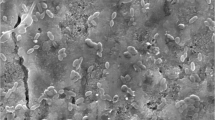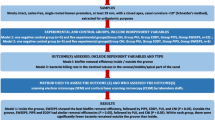Abstract
This study aimed to compare the antibacterial efficacy of standard needle irrigation (SNI), EDDY, passive ultrasonic irrigation (PUI), photon-induced photoacoustic streaming (PIPS), and shock wave enhanced emission photoacoustic streaming (SWEEPS) activation on the teeth with simulated internal root resorption (IRR) and contaminated with Enterococcus faecalis (E. faecalis) using confocal laser scanning microscopy (CLSM) analyses. A total of 79 human maxillary central incisors with a single canal were selected. The canals were accessed, and then, the roots were split in the bucco-lingual direction. Artificial IRR cavities (depth of 0.8 mm and a diameter of 1.6 mm) were prepared using round burs and 20% nitric acid in the middle region of the root halves. The root halves were reconstructed with cyanoacrylate glue, and the canals were contaminated with a culture of E. faecalis for 30 days. Root canal preparation was performed using the ProTaper Next rotary files up to X5 and 2.5% NaOCl irrigation. Teeth were randomly assigned to five groups according to the irrigation activation method (n = 15): SNI, EDDY, PUI, PIPS, and SWEEPS. The final irrigation procedures were performed using a total of 6 mL of 2.5% NaOCl for each tooth with an activation time of 3 × 30 s. The canals were stained with LIVE/DEAD BacLight dye and analyzed with CLSM to determine the percentages of dead bacteria in the biofilm. Two-way ANOVA and post hoc Tukey tests were used for statistical analysis (P < .05). None of the irrigation activation methods tested provided 100% bacterial elimination. There was no significant difference between the irrigation activation methods tested in terms of the percentage of dead bacteria (P > 0.05). In irrigation activation methods other than PIPS, there was no significant difference in the percentage of dead bacteria between the coronal, middle, and apical regions of the roots (P > 0.05). A higher percentage of dead bacteria was found in the middle region compared to the apical region in the PIPS (P < 0.05). Within the limitations of this study, SII, EDDY, PUI, PIPS, and SWEEPS have a similar antimicrobial effect on the teeth with IRR and contaminated with E. faecalis.


Similar content being viewed by others
References
Patel S, Ricucci D, Durak C, Tay F (2010) Internal root resorption: a review. J Endod 36(7):1107–1121. https://doi.org/10.1016/j.joen.2010.03.014
Andreasen JO, Andreasen FM, Andersson L (2018) Textbook and color atlas of traumatic injuries to the teeth, 5th edn. John Wiley & Sons, New Jersey, USA
Kaval M, Güneri P, Çalışkan M (2018) Regenerative endodontic treatment of perforated internal root resorption: a case report. Int Endod J 51(1):128–137. https://doi.org/10.1111/iej.12784
Topçuoğlu H, Düzgün S, Ceyhanlı K, Aktı A, Pala K, Kesim B (2015) Efficacy of different irrigation techniques in the removal of calcium hydroxide from a simulated internal root resorption cavity. Int Endod J 48(4):309–316. https://doi.org/10.1111/iej.12316
Urban K, Donnermeyer D, Schäfer E, Bürklein S (2017) Canal cleanliness using different irrigation activation systems: a SEM evaluation. Clin Oral Investig 21(9):2681–2687. https://doi.org/10.1007/s00784-017-2070-x
Conde A, Estevez R, Loroño G, Valencia de Pablo O, Rossi-Fedele G, Cisneros R (2017) Effect of sonic and ultrasonic activation on organic tissue dissolution from simulated grooves in root canals using sodium hypochlorite and EDTA. Int Endod J 50(10):976–982. https://doi.org/10.1111/iej.12717
Swimberghe R, De Clercq A, De Moor R, Meire M (2019) Efficacy of sonically, ultrasonically and laser-activated irrigation in removing a biofilm-mimicking hydrogel from an isthmus model. Int Endod J 52(4):515–523. https://doi.org/10.1111/iej.13024
Basrani B (2015) Endodontic irrigation: chemical disinfection of the root canal system. Springer International Publishing, Switzerland
De Moor RJ, Meire M, Goharkhay K, Moritz A, Vanobbergen J (2010) Efficacy of ultrasonic versus laser-activated irrigation to remove artificially placed dentin debris plugs. J Endod 36(9):1580–1583. https://doi.org/10.1016/j.joen.2010.06.007
DiVito E, Lloyd A (2012) ER: YAG laser for 3-dimensional debridement of canal systems: use of photon-induced photoacoustic streaming. Dent Today 31(11):122, 124–7
Peters OA, Bardsley S, Fong J, Pandher G, DiVito E (2011) Disinfection of root canals with photon-initiated photoacoustic streaming. J Endod 37(7):1008–1012. https://doi.org/10.1016/j.joen.2011.03.016
Lukac N, Tasic Muc B, Jezersek M, Lukac M (2017) Photoacoustic endodontics using the novel SWEEPS Er: YAG laser modality. J Laser Health Acad 1:1–7
Schneider SW (1971) A comparison of canal preparations in straight and curved root canals. Oral Surg Oral Med Oral Pathol 32(2):271–275. https://doi.org/10.1016/0030-4220(71)90230-1
Pedulla E, Genovese C, Campagna E, Tempera G, Rapisarda E (2012) Decontamination efficacy of photon-initiated photoacoustic streaming (PIPS) of irrigants using low-energy laser settings: an ex vivo study. Int Endod J 45(9):865–870. https://doi.org/10.1111/j.1365-2591.2012.02044.x
Gencoglu N, Yildirim T, Garip Y, Karagenc B, Yilmaz H (2008) Effectiveness of different gutta-percha techniques when filling experimental internal resorptive cavities. Int Endod J 41(10):836–842. https://doi.org/10.1111/j.1365-2591.2008.01434.x
Marques-da-Silva B, Alberton C, Tomazinho F, Gabardo M, Duarte M, Vivan R, Baratto-Filho F (2020) Effectiveness of five instruments when removing calcium hydroxide paste from simulated internal root resorption cavities in extracted maxillary central incisors. Int Endod J 53(3):366–375. https://doi.org/10.1111/iej.13223
Azim AA, Aksel H, Zhuang T, Mashtare T, Babu JP, Huang GT-J (2016) Efficacy of 4 irrigation protocols in killing bacteria colonized in dentinal tubules examined by a novel confocal laser scanning microscope analysis. J Endod 42(6):928–934. https://doi.org/10.1016/j.joen.2016.03.009
Ricucci D, Siqueira JF Jr (2008) Anatomic and microbiologic challenges to achieving success with endodontic treatment: a case report. J Endod 34(10):1249–1254. https://doi.org/10.1016/j.joen.2008.07.002
Burleson A, Nusstein J, Reader A, Beck M (2007) The in vivo evaluation of hand/rotary/ultrasound instrumentation in necrotic, human mandibular molars. J Endod 33(7):782–787. https://doi.org/10.1016/j.joen.2007.04.015
Gabor C, Tam E, Shen Y, Haapasalo M (2012) Prevalence of internal inflammatory root resorption. J Endod 38(1):24–27. https://doi.org/10.1016/j.joen.2011.10.007
da Silveira PF, Vizzotto MB, Montagner F, da Silveira HL, da Silveira HE (2014) Development of a new in vitro methodology to simulate internal root resorption. J Endod 40(02):211–216. https://doi.org/10.1016/j.joen.2013.07.007
Ulusoy Ö, Savur I, Alaçam T, Çelik B (2018) The effectiveness of various irrigation protocols on organic tissue removal from simulated internal resorption defects. Int Endod J 51(9):1030–1036. https://doi.org/10.1111/iej.12919
Du T, Wang Z, Shen Y, Ma J, Cao Y, Haapasalo M (2014) Effect of long-term exposure to endodontic disinfecting solutions on young and old Enterococcus faecalis biofilms in dentin canals. J Endod 40(4):509–514. https://doi.org/10.1016/j.joen.2013.11.026
Swimberghe R, Coenye T, De Moor R, Meire M (2019) Biofilm model systems for root canal disinfection: a literature review. Int Endod J 52(5):604–628. https://doi.org/10.1111/iej.13050
Zhang C, Du J, Peng Z (2015) Correlation between Enterococcus faecalis and persistent intraradicular infection compared with primary intraradicular infection: a systematic review. J Endod 41(8):1207–1213. https://doi.org/10.1016/j.joen.2015.04.008
Stojicic S, Shen Y, Haapasalo M (2013) Effect of the source of biofilm bacteria, level of biofilm maturation, and type of disinfecting agent on the susceptibility of biofilm bacteria to antibacterial agents. J Endod 39(4):473–477. https://doi.org/10.1016/j.joen.2012.11.024
Sathorn C, Parashos P, Messer HH (2007) How useful is root canal culturing in predicting treatment outcome? J Endod 33(3):220–225. https://doi.org/10.1016/j.joen.2006.11.006
Al Shahrani M, DiVito E, Hughes CV, Nathanson D, Huang GT-J (2014) Enhanced removal of Enterococcus faecalis biofilms in the root canal using sodium hypochlorite plus photon-induced photoacoustic streaming: an in vitro study. Photomed Laser Surg 32(5):260–266. https://doi.org/10.1089/pho.2014.3714
Bhuva B, Patel S, Wilson R, Niazi S, Beighton D, Mannocci F (2010) The effectiveness of passive ultrasonic irrigation on intraradicular Enterococcus faecalis biofilms in extracted single-rooted human teeth. Int Endod J 43(3):241–250. https://doi.org/10.1111/j.1365-2591.2009.01672.x
Bao P, Shen Y, Lin J, Haapasalo M (2017) In vitro efficacy of XP-endo Finisher with 2 different protocols on biofilm removal from apical root canals. J Endod 43(2):321–325. https://doi.org/10.1016/j.joen.2016.09.021
Zeng C, Willison J, Meghil MM, Bergeron BE, Cutler CW, Tay FR, Niu L, Ma J (2018) Antibacterial efficacy of an endodontic sonic-powered irrigation system: an in vitro study. J Dent 75:105–112. https://doi.org/10.1016/j.jdent.2018.06.003
Galler K, Grubmüller V, Schlichting R, Widbiller M, Eidt A, Schuller C, Wölflick M, Hiller KA, Buchalla W (2019) Penetration depth of irrigants into root dentine after sonic, ultrasonic and photoacoustic activation. Int Endod J 52(8):1210–1217. https://doi.org/10.1111/iej.13108
DiVito E, Peters OA, Olivi G (2012) Effectiveness of the erbium: YAG laser and new design radial and stripped tips in removing the smear layer after root canal instrumentation. Lasers Med Sci 27(2):273–280. https://doi.org/10.1007/s10103-010-0858-x
Sasanakul P, Ampornaramveth RS, Chivatxaranukul P (2019) Influence of adjuncts to irrigation in the disinfection of large root canals. J Endod 45(3):332–337. https://doi.org/10.1016/j.joen.2018.11.015
Neuhaus KW, Liebi M, Stauffacher S, Eick S, Lussi A (2016) Antibacterial efficacy of a new sonic irrigation device for root canal disinfection. J Endod 42(12):1799–1803. https://doi.org/10.1016/j.joen.2016.08.024
Zhu X, Yin X, Chang JW, Wang Y, Cheung GS, Zhang C (2013) Comparison of the antibacterial effect and smear layer removal using photon-initiated photoacoustic streaming aided irrigation versus a conventional irrigation in single-rooted canals: an in vitro study. Photomed Laser Surg 31(8):371–377. https://doi.org/10.1089/pho.2013.3515
Neelakantan P, Cheng C, Mohanraj R, Sriraman P, Subbarao C, Sharma S (2015) Antibiofilm activity of three irrigation protocols activated by ultrasonic, diode laser or Er: YAG laser in vitro. Int Endod J 48(6):602–610. https://doi.org/10.1111/iej.12354
Zou L, Shen Y, Li W, Haapasalo M (2010) Penetration of sodium hypochlorite into dentin. J Endod 36(5):793–796. https://doi.org/10.1016/j.joen.2010.02.005
Lertchirakarn V, Palamara JE, Messer HH (2003) Patterns of vertical root fracture: factors affecting stress distribution in the root canal. J Endod 29(8):523–528. https://doi.org/10.1097/00004770-200308000-00008
Rodrigues RCV, Zandi H, Kristoffersen AK, Enersen M, Mdala I, Ørstavik D, Rôças IN, Siqueira JF Jr (2017) Influence of the apical preparation size and the irrigant type on bacterial reduction in root canal–treated teeth with apical periodontitis. J Endod 43(7):1058–1063. https://doi.org/10.1016/j.joen.2017.02.004
Zehnder M (2006) Root canal irrigants. J Endod 32(5):389–398. https://doi.org/10.1016/j.joen.2005.09.014
Funding
This study was founded by Bolu Abant Izzet Baysal University, Scientific Research Projects Coordinatorship (Project No: 2020.06.02.1460).
Author information
Authors and Affiliations
Contributions
SKA and ZUA have made substantial contributions to conception and design; SKA and DE carried out the acquisition of data, analysis, and interpretation of data; SKA, ZUA, and DE have been involved in drafting the manuscript and revising it critically for important intellectual content; and ZUA and SKA have given the final approval of the version to be published.
Corresponding author
Ethics declarations
Ethics approval
All procedures performed in studies were in accordance with the ethical standards of the institutional and/or national research committee. Ethics committee of the Bolu Abant Izzet Baysal University approved the study (No: 2020-130).
Consent to participate
Not applicable.
Conflict of interest
The authors declare no competing interests.
Additional information
Publisher's note
Springer Nature remains neutral with regard to jurisdictional claims in published maps and institutional affiliations.
Rights and permissions
Springer Nature or its licensor (e.g. a society or other partner) holds exclusive rights to this article under a publishing agreement with the author(s) or other rightsholder(s); author self-archiving of the accepted manuscript version of this article is solely governed by the terms of such publishing agreement and applicable law.
About this article
Cite this article
Akdere, S.K., Aydin, Z.U. & Erdönmez, D. Antimicrobial effectiveness of different irrigation activation techniques on teeth with artificial internal root resorption and contaminated with Enterococcus faecalis: a confocal laser scanning,icroscopy analysis. Lasers Med Sci 38, 89 (2023). https://doi.org/10.1007/s10103-023-03748-8
Received:
Accepted:
Published:
DOI: https://doi.org/10.1007/s10103-023-03748-8




